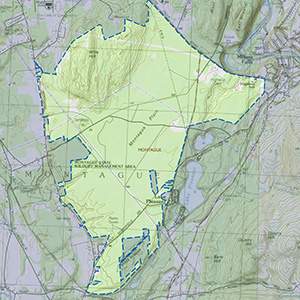Important Bird Area Sites in Massachusetts
Important Bird Area: Montague Sandplains
Site Summary
Nominated By
Dave King
Size
1,750 acres
Towns and Counties
Montague; Franklin
Ownership
MassWildlife, Pioneer Aviation
Major Habitats
38% oak-conifer transition forest, 45% pitch pine/scrub oak, 1.5% early successional shrubland, 1.5% cultural grassland
Land Use
nature/wildlife conservation, hunting/fishing, utility right of way, undeveloped areas, airport
Serious Threats
ecological succession
Minor Threats
cowbird parasitism, recreational development and overuse
IBA Criteria
- Category 1: Sites important for long-term research and/or monitoring projects that contribute substantially to ornithology, bird conservation, and/or education.
- Category 2: Sites containing assemblages of species characteristic of a representative, rare, threatened, or unique habitat within the state or region.
- Category 4: Land Birds: The site is an important migratory stopover or seasonal concentration site for migratory land birds (e.g., warblers). Sites may also qualify on the basis of supporting exceptionally high densities of breeding species as shown from point counts or other surveys or if they represent "migrant traps" relative to surrounding areas. Strong consideration will be given to areas with consistently high overall species diversity..
- Category 5: Sites regularly holding significant numbers of species of high conservation priority in Massachusetts.
Site Description
The Montague sandplains IBA consists of a 1,500-acre state wildlife refuge and unique ecological area, operated by the Massachusetts Department of Fisheries and Wildlife. The "Plains" are a rare pine barren, which supports habitat for many rare plants and animals. The Montague Plains area is located on a large sand delta, formed more than 10,000 years ago when melt water streams from the retreating glaciers emptied into Glacial Lake Hitchcock-a huge lake that covered much of what is now Montague and the Connecticut River Valley during the glacial period. The Turners Falls Airport is a developed part of the Montague Plains but still has remnants of a pitch pine/scrub oak plant community. Grassland habitat is maintained by mowing and burning as part of the airport maintenance requirements. Four species of grassland birds breed here including Grasshopper sparrows and Vesper Sparrows.
Current Conservation Status
Protected. The IBA status of this site is based largely on the presence of early-successional species such as the Whip-poor-will, Prairie Warble,r and Brown Thrasher. These species are declining throughout much of the Northeast, largely because of the disruption of natural disturbance patterns. The Montague plains are no exception: the open, shrubby character of the vegetation is being lost as canopy closure increases, and unless measures are taken to reverse succession many of these declining bird species will be locally extirpated. There are 700 additional acres of pitch pine-scrub oak habitat contiguous with the MassWildlife area that should be considered for addition to this IBA at a future date. The grasslands at this adjacent site are maintained regularly to facilitate the operation of the airport. The frequency and type of maintenance may affect endangered and rare grassland birds negatively or positively. Oversight of maintenance activities to ensure that they benefit these bird species would be extremely desirable.
Ornithological Significance
This site qualifies as an IBA under criterior 1 because of the presence of breeding Vesper and Grasshopper Sparrow. This site qualifies as an IBA under criterior 2 because of the presence of the following bird species with >1% of their range in Massachusetts: Eastern Phoebe, Wood Thrush, Gray Catbird, Blue-winged Warbler, Scarlet Tanager, and Baltimore Oriole. Also, the following Partners in Flight High Conservation Priority Species are present: American Woodcock, Black-billed Cuckoo, Whip-poor-will, Chimney Swift, Hairy Woodpecker, Eastern Wood-Pewee, Least Flycatcher, Great-crested Flycatcher, Eastern Kingbird, Veery, Brown Thrasher, Chestnut-sided Warbler, Prairie Warbler, Black-and-white Warbler, American Redstart, Indigo Bunting, Eastern Towhee, Rose-breasted Grosbeak, and Grasshopper Sparrow. This site qualifies as an IBA under criterior 4 because it is the largest and least fragmented and developed remaining glacial sandplain in the watershed featuring a unique inland pitch pine/scrub oak plant community with at least 10 rare plant and invertebrate species, and sandplain grassland. Finally, this site is near Harvard Forest and several universities, and the flora and fauna of the site have been the subject of numerous research papers, including one in Ecological Monographs, and at least one dissertation on birds, and thus qualifies under criterior 5.
Other Flora or Fauna of Significance
At least 10 rare plant and invertebrate species are referred to in a USFWS evaluation of the site. A wetland within the sandplain is habitat for the endangered Northeastern Bulrush.
Data Sources
All of the above population estimates were derived by multiplying acreage of suitable habitat times the published estimates for density of that species, with the exception of Whip-poor-will, which is an estimate by Seth Kellogg based on years of birding at the Montague Sandplain.
Jones, A.L. and P.D. Vickery. 1997. Distribution and population status of grassland birds in Massachusetts. In Grasslands of Northeast North America (Vickery, P. D. and P.W. Dunwiddie, eds.) Massachusetts Audubon Society, Lincoln, MA.
Jones, A.L. 2000. Breeding ecology of Grasshopper Sparrows in Massachusetts: a comparison of insular and mainland populations. Chapter 1, M.S. Thesis, University of Massachusetts, Amherst, MA.




